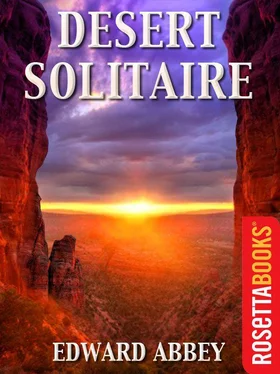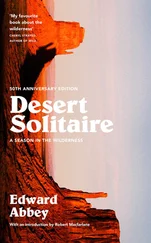Abbey, Edward - Desert Solitaire (Edward Abbey Series )
Здесь есть возможность читать онлайн «Abbey, Edward - Desert Solitaire (Edward Abbey Series )» — ознакомительный отрывок электронной книги совершенно бесплатно, а после прочтения отрывка купить полную версию. В некоторых случаях можно слушать аудио, скачать через торрент в формате fb2 и присутствует краткое содержание. Год выпуска: 2011, Издательство: RosettaBooks, Жанр: Старинная литература, на английском языке. Описание произведения, (предисловие) а так же отзывы посетителей доступны на портале библиотеки ЛибКат.
- Название:Desert Solitaire (Edward Abbey Series )
- Автор:
- Издательство:RosettaBooks
- Жанр:
- Год:2011
- ISBN:нет данных
- Рейтинг книги:4 / 5. Голосов: 1
-
Избранное:Добавить в избранное
- Отзывы:
-
Ваша оценка:
- 80
- 1
- 2
- 3
- 4
- 5
Desert Solitaire (Edward Abbey Series ): краткое содержание, описание и аннотация
Предлагаем к чтению аннотацию, описание, краткое содержание или предисловие (зависит от того, что написал сам автор книги «Desert Solitaire (Edward Abbey Series )»). Если вы не нашли необходимую информацию о книге — напишите в комментариях, мы постараемся отыскать её.
Desert Solitaire (Edward Abbey Series ) — читать онлайн ознакомительный отрывок
Ниже представлен текст книги, разбитый по страницам. Система сохранения места последней прочитанной страницы, позволяет с удобством читать онлайн бесплатно книгу «Desert Solitaire (Edward Abbey Series )», без необходимости каждый раз заново искать на чём Вы остановились. Поставьте закладку, и сможете в любой момент перейти на страницу, на которой закончили чтение.
Интервал:
Закладка:
Amazing, says Waterman, going to sleep.
The old moon, like a worn and ancient coin, is still hanging in the west when I awake. All night long the wind has been blowing, haunting my dreams with intimations of disaster, and in the east above the rim and mountains are salmon-colored clouds whipped into long, sleek, fishlike shapes by the wind. Portents: Red skies at morning, sailors take warning. Northeast the sky is vaguely overcast, a pallid gray.
As I start a fire and prepare breakfast the wind stops, suddenly, and the tremendous silence flows back, sealing the canyon country beneath a transparent dome of timelessness. The sun comes up, a resounding fire, the great golden gong of the dawn: Waterman stirs feebly in his bag.
After breakfast we get ready for the descent into The Maze, the first so far as we know since the Indians left seven centuries before—if they were here at all. Once again Waterman checks the beautiful rope, all one hundred and fifty feet of it, and his other climbing equipment, while I divide and pack our rations for the day: raisins, shelled nuts, hard chocolate, cheese, dried beef, oranges and water.
The drop-off over the white rim is too far for our rope but about a mile to the east we find a break in the caprock where we can descend to the dark-red stratum below. We are still nearly a thousand feet above the actual floor of The Maze. We traverse the red ledge in a westerly direction and find some notches through which we can climb down to the bulging, rounded, buff-colored rock of the Cutler formation, principal material of The Maze and of the similar Needles area on the east side of the river.
Here we find ourselves rimmed-up, five hundred feet or so above the canyon floor. After further exploring we find a good spot for a rappel, with a pinyon pine to serve as belay. The only trouble is that it is impossible to see from here whether or not there is a feasible route the rest of the way down. If further descent turns out to be impossible, then whoever goes down the rope first is going to be in a tough situation. The wall at this point is somewhat overhanging, requiring a free rappel of forty to fifty feet—easy enough going down but cruel hard work to get back up. I don’t know about Waterman but am certain that I could never climb that far up a rope myself. Of course there are various techniques for doing it but none of them is easy. I invite Waterman to go first, he invites me, and we waste about ten minutes in the Alphonse-Gaston routine.
He loses patience first, as I felt sure he would, gets into a sling, hooks up his carabiners, runs the doubled rope around a brake bar, backs over the edge and slides out of sight. I crawl along a narrow shelf to one side and watch him free himself from the rope and disappear below among the crevices and boulders. Presently he comes back and tells me to come on down, he has found a way clear to the bottom.
So it’s my turn to dangle in mid-air. I’ve never made a free rappel before and am a little nervous about it. As I lean back over the edge I can’t help but look down and the sight of Waterman far below looking up at me is frankly kind of sickening.
“What are you waiting for?” he wants to know.
“Are you sure this rope is strong enough?”
“It held me, didn’t it?”
“Yes, but I weigh more than you do.”
“Well, give it a try anyway.”
A very humorous fellow. But there’s no honorable way out of this for me. After another minute of equivocation and technical inquiries, I lean back farther, keeping my eyes on the rope, and go down. Nothing to it. Half an hour later we’re down on the sandy floor of the canyon and inside The Maze. We’ve brought the rope with us, of course, and therefore will have to find a different route up to the rim, if there is one. But that problem can be deferred for a while. If necessary we’ve got enough food for two days.
The air is hot, clear, dry and our canteens nearly empty; we’ve taken three hours in the descent. The first thing we’ve got to do is find water. We start walking down the canyon. If we keep going we will reach the Green River, about ten miles away according to our map, just above its confluence with the Colorado. There may, of course, be obstacles; we don’t know.
Within half a mile, however, we find cottonwoods and shoals of damp, firm sand on the canyon floor. I dig a hole as big around as my fist and elbow-deep and come to wet gravel; a few more inches and I find water.
There is a stand of wild cane nearby. I cut two stalks, a fat one and a thin one, and punch the pith out of the joints of the bigger one by using the smaller as a ramrod. Happy now, greatly relieved, I recall for Waterman’s edification a few appropriate lines from Burns:
Green grow the rashes, O!
Green grow the rashes, O!
The lasses they have cozy bores,
The widows all have gashes, O!
Now we’ve got a siphon, two feet long. I offer it to the thirsty Waterman, he sticks it in the hole and drinks heartily. When he is finished I take it, blow out the sand, and also drink. The water is warm, smelly, but potable and quite refreshing. Feeling much better we sit in the shade of the trees and eat some lunch. I cut a few holes at odd intervals in the drinking straw, creating a sort of crude recorder, and play a few tunes in a barbarous scale never heard before this side of the Atlas Mountains. I stop, Waterman comes back and lies down for a siesta. I go exploring.
At one place on the canyon wall I find three arches or natural bridges, one above another, all three spanning the same drainage chute. Going farther up-canyon I come to a fork, the first of many branches in the canyon system. The main or wider canyon turns to the left, revealing vistas of alluvium flats covered with sagebrush, more cottonwoods, more and more branching canyons with deep alcoves high in their walls, likely sites for Indian ruins. But I keep to the right, under the rim of the overlook where we had camped the night before, and scan the walls for a possible route to the top.
I come after a time to a lovely pool in a basin of sand, fed by a trickle of water flowing down the canyon’s rocky floor. I drink again, fill my canteen and go on. This canyon, like all the others, forks again and again; I keep to the right-hand branch each time and finally arrive at a dead end, a box, with unscalable walls rising three, four, five hundred feet straight up toward the hot blue sky. I go back to the pool and take a dip in the water.
Lying on my back on the smooth sandstone beside the pool I notice a fingerlike ridge that juts into the canyon from the base of the main wall under the plateau above. If we can climb the ridge to the maroon bench above the Cutler, we might be able to traverse laterally to the opening in the white rim through which we had originally descended. From here it looks as if it might go.
I’m just starting up to investigate the ridge when Waterman appears, tracking me up the canyon floor. He joins me, we climb the ridge together and discover that it does indeed go all the way to the red ledge. There are a couple of tricky pitches with rotten rock and fingerholds of exquisite delicacy but most of the way is easy. We return to the bottom of The Maze to get our packs and the rope, and to do a little more exploring, if possible.
It is now late in the afternoon. We don’t have much time left before sundown. Our sleeping bags are up on the rim in the Land Rover and we have nothing to eat but nuts and raisins. We decide it best to climb out of The Maze before dark and save further exploration for tomorrow. We go back to the pool and the base of the ridge. On the way Waterman points out to me the petroglyph of a snake, which I had missed. The Indians had been here. But nobody else, so far as we can tell. Nowhere have we seen a trace of the white man or of his horse or cow—or helicopter. But then we have seen only a tiny corner of The Maze, maybe no more than one percent of it. The heart of it remains unknown.
Читать дальшеИнтервал:
Закладка:
Похожие книги на «Desert Solitaire (Edward Abbey Series )»
Представляем Вашему вниманию похожие книги на «Desert Solitaire (Edward Abbey Series )» списком для выбора. Мы отобрали схожую по названию и смыслу литературу в надежде предоставить читателям больше вариантов отыскать новые, интересные, ещё непрочитанные произведения.
Обсуждение, отзывы о книге «Desert Solitaire (Edward Abbey Series )» и просто собственные мнения читателей. Оставьте ваши комментарии, напишите, что Вы думаете о произведении, его смысле или главных героях. Укажите что конкретно понравилось, а что нет, и почему Вы так считаете.












